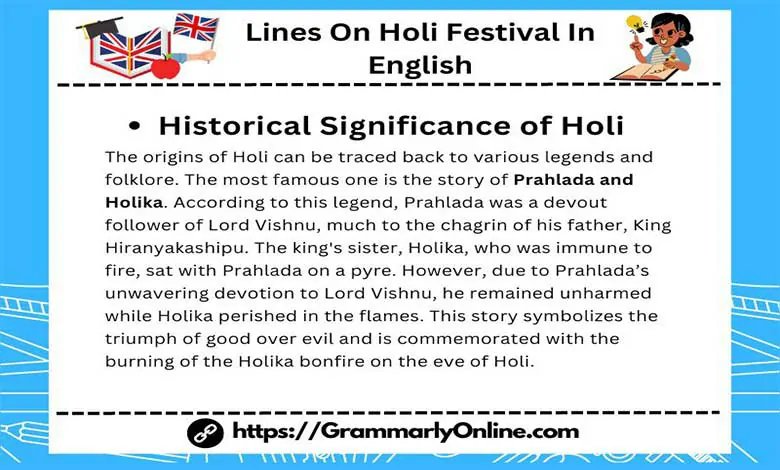10 Lines On Holi Festival In English

The Holi Festival, also known as the Festival of Colors, is one of the most vibrant and joyous festivals celebrated in India and around the world. This ancient Hindu festival signifies the victory of good over evil, the arrival of spring, and the end of winter. It is a day to meet others, play and laugh, forget and forgive, and repair broken relationships. The festival is celebrated with a multitude of traditions, each adding a unique flavor to the overall experience.
Historical Significance of Holi
The origins of Holi can be traced back to various legends and folklore. The most famous one is the story of Prahlada and Holika. According to this legend, Prahlada was a devout follower of Lord Vishnu, much to the chagrin of his father, King Hiranyakashipu. The king’s sister, Holika, who was immune to fire, sat with Prahlada on a pyre. However, due to Prahlada’s unwavering devotion to Lord Vishnu, he remained unharmed while Holika perished in the flames. This story symbolizes the triumph of good over evil and is commemorated with the burning of the Holika bonfire on the eve of Holi.
Cultural and Social Relevance
Holi transcends religious boundaries and is celebrated by people of various faiths across India. It is a festival that brings communities together, fostering a sense of unity and brotherhood. The festival is marked by the throwing of colored powders, known as Gulal, and colored water on each other, symbolizing the breaking down of social barriers and the spread of love and happiness.
Traditional Holi Celebrations
The celebrations of Holi begin with Holika Dahan, where people gather around a bonfire, performing rituals and praying for the destruction of evil. The next day is Rangwali Holi, the main festival day, where participants play with colors, dance, and sing traditional songs. The atmosphere is filled with laughter and joy as people smear each other with colors, drench each other with water, and enjoy festive foods and drinks like Gujiya, Thandai, and Bhang.
Modern Day Celebrations
In modern times, Holi has gained global recognition and is celebrated with great enthusiasm in various parts of the world, including the United States, United Kingdom, Australia, and Canada. These celebrations often include large gatherings, music festivals, and color runs, where participants throw colored powders and dance to Bollywood tunes. The universal appeal of Holi lies in its message of love, inclusivity, and the joy of life.
Impact on Indian Culture
Holi has a profound impact on Indian culture, influencing various aspects of art, literature, and cinema. It is a recurring theme in Indian films and literature, symbolizing joy, the celebration of life, and the triumph of good over evil. The festival also plays a significant role in promoting traditional Indian music and dance forms, as it is often accompanied by folk songs and dances like Bhangra and Garba.
Environmental Concerns and Sustainable Practices
In recent years, there has been a growing awareness about the environmental impact of Holi celebrations, particularly the use of synthetic colors and water wastage. Many communities are now adopting eco-friendly practices, such as using natural and organic colors made from flowers and herbs, and celebrating a dry Holi to conserve water. These practices help in preserving the environment while maintaining the spirit of the festival.
Holi and the Spirit of Togetherness
One of the most beautiful aspects of Holi is the way it brings people together, regardless of their social, economic, or cultural backgrounds. The festival is an opportunity to mend broken relationships, forgive past grievances, and start anew with a spirit of camaraderie and goodwill. The act of applying colors on each other is symbolic of this spirit of togetherness and the universal desire for peace and harmony.
Educational Value of Holi
Holi is not just a festival of fun and frolic; it also offers valuable lessons in cultural heritage, traditions, and values. Educational institutions often organize Holi celebrations and activities that teach students about the historical significance, cultural relevance, and environmental aspects of the festival. These activities help in instilling a sense of pride and appreciation for Indian culture and traditions among the younger generation.
Conclusion
The Holi Festival is a vibrant and joyous celebration that embodies the essence of Indian culture and traditions. From its historical origins and cultural significance to its modern-day celebrations and environmental consciousness, Holi is a festival that resonates with people across the world. It is a time to celebrate life, love, and the triumph of good over evil. As we come together to celebrate Holi, let us embrace its message of unity, inclusivity, and the joy of living.

